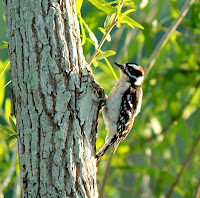We made a visit to Casa De Meadows again today. Joan spotted something along the shoreline of the pond. She described what she saw as something as big as a brown Bear Cub. She hopped out of the car to get a closer look when it took flight, it was a Bald Eagle. It flew across the pond to the opposite side of the development. We drove over to that side and spotted the Eagle perched on a limb in a pine tree. We both hopped out and started taking photos and videos. The Eagle stared at us for about 30 seconds then, flew back to the other side. While in flight, the Eagle was met in mid-air by another Eagle, and together they flew out of sight. What a treat, if only for a moment.
Today's Eagle photo shows what we believe to be a "third year" bird, based on our field guide. It still has streaky brown feathers on its head and dark tips on its tail. It also has spotty white feathers on its breast and wings. We also believe that this particular Eagle is a female. Female Bald Eagles can be up to 25 percent larger than males. This bird is about twice as far away as an Eagle we spotted in July yet, it's much larger. Enjoy these Bald Eagle photos.....tweet.....tweet!!
 |
| Bald Eagle (Taken 9/30/12, Englewood FL) |
 |
| Bald Eagle (Taken 7/22/12, Port Charlotte FL) http://www.allaboutbirds.org/guide/Bald_Eagle/id |
+-+Copy+-+Copy.JPG)

.JPG)

























.JPG)





.JPG)








.JPG)

